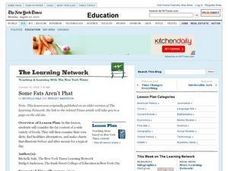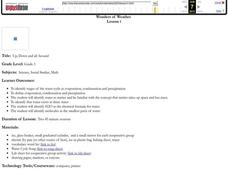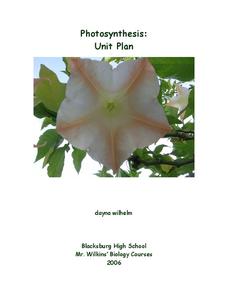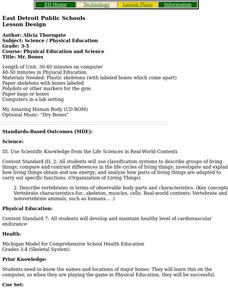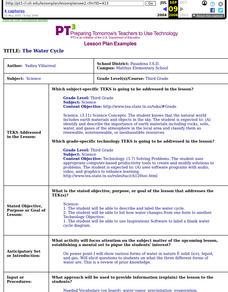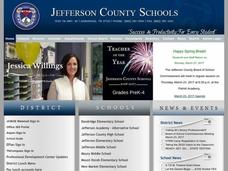Curated OER
Planting a Rainbow Bulletin Board
Students explore a variety of colors and shapes after reading the story, "Planting A Rainbow," by Lois Ehlert. The tracking and reading of labels attached to diagrams form an experience in vocabulary development in this lesson.
Curated OER
A simple computer
In this circuit worksheet, students build a circuit simulating a simple computer using light bulbs, breadboards, push pins and more. Students then complete a chart and answer 1 question.
Curated OER
Parts of a Plant
First graders discover the parts of a plant. In this science lesson, 1st graders identify and label the parts of a plant and record their findings on a word processor.
Curated OER
Cartoons for the Classroom: The Climate Change Debate
Is global warming all smoke and mirrors? Find out what your scholars think with this handout, which has them analyzing two political cartoons on the topic. Background information gives context, detailing the computer hacking during the...
Curated OER
Some Fats Aren't Phat
Young scholars examine nutritional information on various food labels and then consider the nutritional value of the foods in their own diets. They create posters illustrating their diets "before" and "after" they considered their fat...
Curated OER
Measuring & Graphing Motion
Fifth graders study how to measure distance. In this graphing motion lesson students complete a lab activity that shows them on the computer how to make graphs.
Curated OER
Cell Organelles and Their Functions
Students will be using Inspiration, which is a graphic organizer computer program, to create their own model community where they will label the community parts with the corresponding organelle. They will have prior knowledge of cell...
Curated OER
Blast the Fats
Students examine the fats found in foods. In this nutrition lesson, students identify the types and amounts of fats found in foods as they research food labels and the Internet. Students classify the fats and record their data.
Curated OER
How Are Plants Similar And Different?
Studetns create an index card database of different categories of plants such as bushes, trees, flowers, grasses and vegetables. They review the different parts of a plant and label pictures of plants on the database cards. They use the...
Curated OER
Wonders of Weather
Fourth graders complete activities to study weather and the water cycle. In this water cycle lesson, 4th graders observe a demonstration of the three stages of water. Students work in groups to complete a water cycle lab activity....
Virginia Department of Education
Hurricanes: An Environmental Concern
Hurricanes, typhoons, and tropical cyclones are the same type of storm, but their names change based on where they happen. Scholars use a computer simulation to learn about hurricanes. Then they hypothesize ideas to prevent hurricanes...
Curated OER
Photosynthesis
We all know photosynthesis happens, but why should we care? Here is a unit that covers everything young scholars need to know about photosynthesis. Hands-on activities, assessments, and lectures guide pupils though the physiology of...
Curated OER
Mr. Bones
Students play CD-ROM game My Amazing Human Body, and participate in relay game in Phys. Ed. where they put together skeleton on which body parts are labeled.
Curated OER
HOW BODY SYSTEMS INTERACT
Students study that the human body is made up of different systems whose functions are related. They draw and label their traced body outlines which include at least five body systems.
Curated OER
An Eye on Science
Students investigate the human eye and its parts. They read and discuss various books about eyes and sight, draw a rough draft of an eye diagram, and create a final draft of their eye diagram including labeled parts using Kid Pix...
Curated OER
Make a Model of a Tree
Students identify the parts of a tree. In this tree biology lesson, students create a tree model using tree parts and drawing the roots. Students label each part of the tree and maintain a tree journal during this unit.
Curated OER
Bread Cells
Fifth graders examine plant and animal cells. In this plant and animal cell instructional activity, 5th graders define what cells are, label their parts, and describe how plant and animal cells are different. They observe cells at a...
Curated OER
The Water Cycle--Using Inspiration Software
Third graders describe and label the water cycle, and list how water changes from one form to another; students use Inspiration Software to label a blank water cycle diagram.
Curated OER
Sea Animal Slide Show
Students cllassify sea animals into groups based on certain attributes. They create a picture on ClarisWorks for Kids. They write/wordprocess their own name and copy words from immediate environment to label sea animals.
Alabama Learning Exchange
Flutter By, Butterfly!
Learners examine the basic characteristics of butterflies. They view a butterfly PowerPoint presentation, complete various labelling activity sheets, explore websites, and design a poster that includes facts and illustrations to be used...
Curated OER
Skeletal System
Seventh graders identify and label twenty-five bones of the skeletal system. In small groups they glue various types of dried pasta to a large human body outline. They attach the pasta to the outline and label the pasta bones.
Curated OER
28 Days - The Lunar Cycle time line
Third graders create a labeled lunar diagram time line illustrating the lunar cycle using Internet resources. An assigned date/month is given to each student, and an online Moon Phase calculator assists them with their drawings.
Curated OER
Animal Morphs
Learners explore animal drawing. In this cross curriculum drawing, photography, and animals lesson, students combine computer drawing and freehand drawing to create an animal and its environment using a photograph of their...
Curated OER
The 400-acre wood
For this forest planning lesson plan, students visit the 400-acre wood website and work in groups to learn about the specific aspects of forest development. Students create, label and color a forest planning map and present their...




